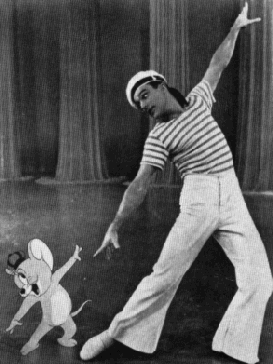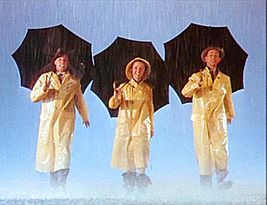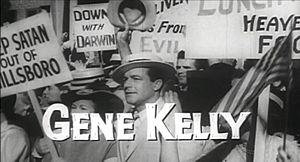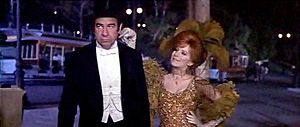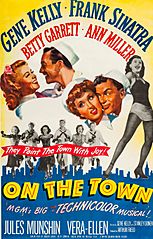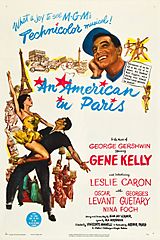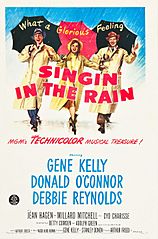Gene Kelly facts for kids
Quick facts for kids
Gene Kelly
|
|
|---|---|
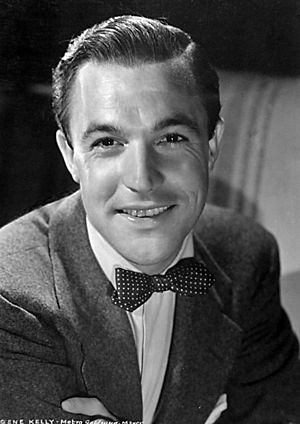
Kelly in 1943
|
|
| Born |
Eugene Curran Kelly
August 23, 1912 Pittsburgh, Pennsylvania, U.S.
|
| Died | February 2, 1996 (aged 83) |
| Citizenship | American (Irish citizenship granted late in life) |
| Education | Peabody High School |
| Alma mater | University of Pittsburgh |
| Occupation |
|
| Years active | 1931–1994 |
| Known for |
|
| Political party | Democratic |
| Spouse(s) |
Jeanne Coyne
(m. 1960; died 1973)Patricia Ward
(m. 1990) |
| Children | 3 |
Eugene Curran Kelly (born August 23, 1912 – died February 2, 1996) was a famous American dancer, singer, actor, and filmmaker. He was also a talented choreographer, meaning he created dance routines. Gene Kelly was known for his energetic and athletic dancing style. He wanted to make dance something everyone could enjoy, calling it "dance for the common man."
He starred in, choreographed, and co-directed many popular musical films in the 1940s and 1950s, often working with Stanley Donen. Some of his most famous movies include An American in Paris (1951) and Singin' in the Rain (1952). An American in Paris even won an Oscar for Best Picture. He also appeared in other musicals like Cover Girl (1944) and Anchors Aweigh (1945). For Anchors Aweigh, he was nominated for an Academy Award for Best Actor.
Gene Kelly made his first movie with Judy Garland in For Me and My Gal (1942). He also directed films in the 1960s, such as Hello, Dolly! (1969), which was nominated for an Oscar for Best Picture. His ideas greatly changed Hollywood musicals. Many people say he helped make ballet popular for movie audiences. He received an Academy Honorary Award in 1952 for his amazing career. Later, he also got lifetime achievement awards from the Kennedy Center Honors, the Screen Actors Guild, and the American Film Institute. In 1999, the American Film Institute named him the 15th greatest male screen legend of Classic Hollywood Cinema.
Contents
Gene Kelly's Early Life and Education

Gene Kelly was born in Pittsburgh, Pennsylvania. He was the third son of James Patrick Joseph Kelly and Harriet Catherine Curran. When he was eight, his mother enrolled him and his brother James in dance classes. At first, they didn't like it and often got into fights with other kids who teased them. Gene didn't dance again until he was 15 years old.
As a child, his dream was to play shortstop for the Pittsburgh Pirates baseball team. By the time he decided to dance again, he was a good sportsman and could defend himself. He went to St. Raphael Elementary School and graduated from Peabody High School at 16.
He first went to Pennsylvania State College to study journalism. But after the stock market crash in 1929, he left school to help his family. He and his younger brother Fred created dance routines to win money in local talent shows. They also performed in nightclubs.
In 1931, Kelly went to the University of Pittsburgh to study economics. He joined the university's Cap and Gown Club, which put on original musical shows. After graduating in 1933, he directed the club from 1934 to 1938. He even started at the University of Pittsburgh Law School.
His family opened a dance studio in Pittsburgh in 1932, calling it the Gene Kelly Studio of the Dance. They opened a second studio in 1933. Gene taught at the studio while he was in college and law school. He also taught dance and staged a festival for a synagogue in Pittsburgh for seven years.
Gene eventually decided to become a full-time dancer and teacher. He left law school after two months. He focused more on performing. He later said he didn't like teaching as much because there were too many girls compared to boys, and many girls stopped dancing when they turned 16. In 1937, after successfully managing his family's dance business, he moved to New York City to find work as a choreographer. He returned to Pittsburgh in 1940 and worked as an actor in plays.
Gene Kelly's Stage Career
After not finding much work in New York, Gene Kelly went back to Pittsburgh. His first job as a choreographer was for a musical show called Hold Your Hats in April 1938. He also performed in six parts of the show. One of his dances later became a big Spanish dance number in the movie Anchors Aweigh.
In November 1938, he got his first job on Broadway, dancing in Cole Porter's Leave It to Me!. He was hired by Robert Alton, who was impressed by Kelly's teaching skills. In 1939, he was chosen for a musical show called One for the Money.
Kelly's first big success was in the play The Time of Your Life, which opened in October 1939. For the first time on Broadway, he danced to his own choreography. That same year, he got his first job as a Broadway choreographer for Billy Rose's Diamond Horseshoe. He started dating a cast member, Betsy Blair, and they married on October 16, 1941.
In 1940, he got the main role in Pal Joey. This role made him a star. During the show's run, he told reporters that he didn't believe in just one style of dancing. He said he created dances based on what the story and music needed. He used ballet techniques but only what he could adapt for his own style. His co-workers noticed how hard he worked and how much he practiced.
Hollywood started offering him movie roles, but Kelly wasn't in a hurry to leave New York. He eventually signed a contract with David O. Selznick, agreeing to go to Hollywood after Pal Joey finished in October 1941. Before that, he also choreographed the stage show Best Foot Forward.
Gene Kelly's Film Career
Becoming a Star in Hollywood (1941–1945)
Gene Kelly's first movie was For Me and My Gal (1942), starring Judy Garland. He felt nervous seeing himself on the big screen. But the movie did very well. After appearing in a few other films, he got a main role in Du Barry Was a Lady (1943) with Lucille Ball.
His first chance to dance to his own choreography in a movie was in Thousands Cheer (1943). In this film, he performed a funny dance with a mop. He made a big breakthrough as a dancer in film when he worked with Rita Hayworth in Cover Girl (1944). In this movie, he created a memorable dance routine where he danced with his own reflection.
In his next film, Anchors Aweigh (1945), he was allowed to create many dance routines. These included dances with his co-star Frank Sinatra and the famous animated dance with Jerry Mouse. This performance made critics praise Kelly's dancing skills. Anchors Aweigh was a very successful film, and Kelly was nominated for an Academy Award for Best Actor. In Ziegfeld Follies (1946), Kelly danced with Fred Astaire, whom he greatly admired.
Military Service
Gene Kelly was asked to join the military in 1944. He joined the U.S. Navy and was stationed in Washington D.C. He worked in the Photographic Section, where he wrote and directed documentaries. This made him very interested in the production side of filmmaking. He was discharged from the Navy in 1946.
Success with MGM (1946–1952)
After returning from the Navy, Kelly made a movie called Living in a Big Way (1947). The studio asked him to add dance routines, and they noticed how good he was at it. This led to a main role in The Pirate (1948) with Judy Garland. This film showed off Kelly's athletic dancing. It also featured his work with the Nicholas Brothers, who were famous Black dancers. Even though it's now seen as a classic, the movie didn't do well at the box office at the time.

MGM wanted Kelly to make more popular movies. But he kept fighting for a chance to direct his own musical film. He also played d'Artagnan in The Three Musketeers (1948). He was supposed to star in Easter Parade (1948), but he broke his ankle playing volleyball. He convinced Fred Astaire to come out of retirement to replace him in the film.
Next, he made Take Me Out to the Ball Game (1949), his second movie with Frank Sinatra. In this film, Kelly honored his Irish background with a dance routine. This musical convinced Arthur Freed to let Kelly make On the Town (1949), where he worked with Frank Sinatra for the last time. This movie was a big step forward for musicals. It was one of the first musicals to be filmed outside of a studio, in real places.
Stanley Donen, who was Kelly's assistant choreographer, got credit as co-director for On the Town. Kelly said that Stanley was no longer just an assistant but a co-creator. Together, they changed how musicals were made, moving them out of the studio and into real locations. Kelly also brought modern ballet into his dance sequences more than ever before.
Kelly then took a straight acting role in the drama Black Hand (1950). This movie was about organized crime in New York's "Little Italy" in the late 1800s. After that, he made Summer Stock (1950), which was Judy Garland's last musical for MGM. In this movie, Kelly performed a solo dance with a newspaper and a squeaky floorboard.
Then came two musicals that made Gene Kelly a huge star in American musical films: An American in Paris (1951) and Singin' in the Rain (1952). As co-director, main star, and choreographer, Kelly was the driving force behind both movies.
An American in Paris won six Academy Awards, including Best Picture. The film also introduced 19-year-old ballerina Leslie Caron, whom Kelly discovered in Paris. Its dream ballet sequence, which lasted 17 minutes, was very expensive to film. Critics loved it. In 1951, Kelly also received an honorary Academy Award for his work in film musicals and choreography.
The next year, Singin' in the Rain featured Kelly's famous solo dance to the title song, which has been copied many times. It also had the "Moses Supposes" dance with Donald O'Connor and the "Broadway Melody" finale with Cyd Charisse. While An American in Paris was more popular at first, Singin' in the Rain is now considered one of the greatest film musicals ever.
Later Career (1953–1996)
After his big successes, Kelly signed a contract with MGM that sent him to Europe for 19 months. He made three movies there. Only one was a musical, Invitation to the Dance, which was a special project for Kelly to bring modern ballet to wider audiences. This film had many delays and problems and didn't do well when it was released in 1956.
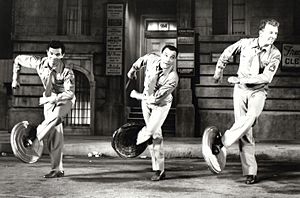
When Kelly returned to Hollywood in 1953, musical films were becoming less popular because of television. MGM cut the budget for his next movie, Brigadoon (1954), starring Cyd Charisse. This forced him to film it on studio sets instead of in Scotland. He also appeared with his brother Fred in a dance routine in Deep in My Heart (1954).
His relationship with MGM became strained when they wouldn't let him star in other films. He negotiated to leave his contract after making three more movies for MGM. The first was It's Always Fair Weather (1955), which he co-directed with Donen. This musical was a satire about television and advertising. It included his roller-skate dance routine and a dance trio with Michael Kidd and Dan Dailey. MGM didn't think Kelly's movies would make much money anymore.
Next was Kelly's last musical film for MGM, Les Girls (1957). The third movie he made was a low-budget film called The Happy Road (1957), set in France. This was his first time as a producer, director, and actor in the same film. After leaving MGM, Kelly went back to working on stage.
In 1958, Kelly directed the musical play Flower Drum Song. In 1960, he was invited to create a modern ballet for the Paris Opéra, which was a big honor for an American. The ballet, called Pas de Dieux, was a success. He was then honored with the Chevalier de la Légion d'Honneur by the French Government.
Kelly continued to appear in some films, like Inherit the Wind (1960). However, he focused more on directing and producing films. He directed Jackie Gleason in Gigot (1962), but the film was changed and didn't do well. He also appeared in Jacques Demy's musical The Young Girls of Rochefort (1967), which was popular in France but not elsewhere.
His first TV show was a documentary for NBC called Dancing is a Man's Game (1958). In this show, he brought together famous American sportsmen like Mickey Mantle and Sugar Ray Robinson. He reinterpreted their moves as dances. He wanted to show that dancing was not just for women and to explain his dance style. The show was nominated for an Emmy Award for choreography.
Kelly appeared on many TV shows in the 1960s, including Going My Way (1962–63). He also appeared in three big TV specials: The Julie Andrews Show (1965), New York, New York (1966), and Jack and the Beanstalk (1967). He produced and directed Jack and the Beanstalk, which combined cartoons and live dance. It won him an Emmy Award for Outstanding Children's Program.
In 1967, he directed the successful movie A Guide for the Married Man, starring Walter Matthau. Then, he got a big chance to direct Hello, Dolly! (1969), again directing Matthau along with Barbra Streisand. The film was nominated for seven Academy Awards and won three.
In 1970, he made another TV special called Gene Kelly and 50 Girls. He directed veteran actors James Stewart and Henry Fonda in the Western comedy The Cheyenne Social Club (1970), which didn't do well. In 1973, he worked with Frank Sinatra again on Sinatra's TV special. He appeared as a narrator in the popular movie That's Entertainment! (1974). He directed and co-starred with his friend Fred Astaire in the sequel That's Entertainment, Part II (1976). He convinced the 77-year-old Astaire to perform song-and-dance duets, bringing back memories of the golden age of American musical films.
Kelly continued to appear on TV often. His last film role was in Xanadu (1980), which was a surprise flop despite a popular soundtrack. In 1985, he was an executive producer and co-host of That's Dancing!, which celebrated the history of dance in American musicals. Kelly's final on-screen appearance was to introduce That's Entertainment! III (1994). His last film project was the animated movie Cats Don't Dance, released in 1997, for which he was a dance consultant. The movie was dedicated to his memory.
Gene Kelly's Dance Style and Influence
Gene Kelly worked hard to combine dance with film. He used lighting, camera tricks, and special effects to make dance look natural on screen. He was one of the first to use split screens, double images, and mix live action with animation. He is known for making ballet acceptable to movie audiences.
His dance style changed over time, from tap and musical comedy to more complex ballet and modern dance. Kelly himself said his style was a mix of different forms. He took ideas from modern dance, classical ballet, and American folk dances like tap and jitterbug. He wanted to create a style that fit his background. He said he had a lot of George M. Cohan in him, which meant he had an Irish, confident, and energetic quality. He was also influenced by an African-American dancer named Robert Dotson and studied ballet and Spanish dancing.

Kelly's work is seen as a great example of how dance and film came together in the 1940s and 1950s. While Fred Astaire changed how dance was filmed by showing dancers in full view, Kelly made the camera move more. He used more space, camera movement, angles, and editing. He believed that the energy of live dance often got lost on film. So, he made the camera move with the dancer, making the camera lens like the viewer's eye.
Kelly's athletic body gave his dances a strong, muscular feel. He believed that dancing was a "man's game" and that men could dance better than women. He also wanted to break away from the fancy costumes like top hats and tuxedos that were common in dance films. He preferred to dance in casual clothes to make his dancing more relatable to everyday people. He wanted to create a different image from Fred Astaire, saying that Astaire looked elegant in formal wear, but he looked like a "truck driver."
Gene Kelly's Personal Life
From the mid-1940s to the early 1950s, Gene Kelly and his first wife, Betsy Blair, hosted weekly parties at their home in Beverly Hills, California. They often played a very competitive game of charades.
Kelly was granted Irish citizenship later in his life. On December 22, 1983, his Beverly Hills mansion burned down due to faulty Christmas tree wiring. His family and pets escaped safely, and he only suffered a burned hand.
Marriages and Family
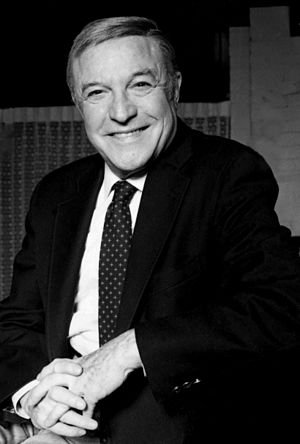
Gene Kelly was married three times.
- His first marriage was to actress Betsy Blair in 1941. They had one child, Kerry (born 1942). They divorced in April 1957.
- In 1960, Kelly married his dance assistant Jeanne Coyne. She had two children with Kelly: Timothy (born 1962) and Bridget (born 1964). This marriage lasted until Jeanne died in 1973.
- Kelly married Patricia Ward in 1990 when he was 77 and she was 30. Their marriage lasted until his death six years later.
Political and Religious Views
Gene Kelly was a lifelong supporter of the Democratic Party. During the McCarthy era in the U.S., when people were suspected of being communists, Kelly stood up for others. His first wife, Betsy Blair, was suspected of being a communist supporter. When a movie studio thought about removing her from a film, Kelly threatened to leave his own movie unless she was allowed to keep her part. He also helped solve disagreements between unions and Hollywood studios.
He was raised as a Roman Catholic. However, he officially left the church in September 1939. After that, Kelly became an agnostic, meaning he believed it was impossible to know if God exists.
Illness and Death
Gene Kelly's health began to decline in the late 1980s and early 1990s. In July 1994, he had a stroke and stayed in the hospital for seven weeks. In early 1995, he had another stroke, which left him severely disabled. Gene Kelly died on February 2, 1996. His body was cremated without a funeral or memorial service.
Awards and Honors
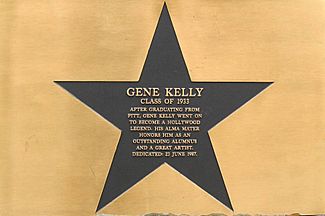
- 1942 – Best Actor award from the National Board of Review for For Me and My Gal.
- 1946 – Academy Award nomination for Best Actor in Anchors Aweigh.
- 1951 – Nominated for a Golden Globe Award for Best Actor in An American in Paris.
- 1952 – Honorary Academy Award for his amazing work as an actor, singer, director, and dancer, especially for his choreography in films.
- 1953 – Nomination from the Directors Guild of America for Best Director for Singin' in the Rain (shared with Stanley Donen).
- 1956 – Golden Bear award at the 6th Berlin International Film Festival for Invitation to the Dance.
- 1958 – Dance Magazine's annual TV Award for Dancing: A Man's Game.
- 1960 – Made a Chevalier of the Legion of Honor in France.
- 1960 – Received a star on the Hollywood Walk of Fame.
- 1962 – The Museum of Modern Art held a Gene Kelly Dance Film Festival.
- 1964 – Best Actor Award for What a Way to Go! at the Locarno International Film Festival.
- 1967 – Emmy for Outstanding Children's Program for Jack and the Beanstalk.
- 1970 – Nomination for Golden Globe, Best Director for Hello, Dolly!.
- 1970 – Nomination from the Directors Guild of America, Best Director for Hello, Dolly!.
- 1981 – Cecil B. DeMille Award at the Golden Globes.
- 1982 – Lifetime Achievement Award in the Kennedy Center Honors.
- 1985 – Lifetime Achievement Award from the American Film Institute.
- 1989 – Life Achievement Award from the Screen Actors Guild.
- 1991 – The Pittsburgh Civic Light Opera started the Gene Kelly Awards for high-school musicals.
- 1992 – Inducted into the American Theater Hall of Fame.
- 1994 – Awarded the National Medal of Arts by President Bill Clinton.
- 1996 – Honorary César Award, a top film award in France.
- 1996 – A tribute to Kelly was performed at the Academy Awards ceremony.
- 1999 – Ranked number 15 in the American Film Institute's "Greatest Male Legends" of Classic Hollywood list.
Gene Kelly's Work
-
Singin' in the Rain (1952)
Musical Films
Gene Kelly acted and danced in many musical films. He always created his own dance routines and often helped choreograph for others. He usually wasn't formally credited in the movie titles, which was common at the time.
Theatre Work
| Date | Production | Role | Venue |
|---|---|---|---|
| 1938–1939 | Leave It to Me! | Secretary to Mr. Goodhue Chorus |
Imperial Theatre, Broadway |
| 1939 | One for the Money | Ensemble | Booth Theatre, Broadway |
| 1939–1940 | The Time of Your Life | Performer – Harry Choreographer |
|
| 1940–1941 | Pal Joey | Performer – Joey Evans | Ethel Barrymore Theatre, Broadway St. James Theatre, Broadway |
| 1941–1942 | Best Foot Forward | Choreography | Ethel Barrymore Theatre, Broadway |
| 1958–1960 | Flower Drum Song | Director | St. James Theatre, Broadway |
| 1974 | Take Me Along | Performer – Sid Davis | The Muny, Regional |
| 1979 | Coquelico | Producer | 22 Steps, New York |
| 1985–1986 | Singin' in the Rain | Original film choreography | Gershwin Theatre, Broadway |
Television Appearances
| Year | Title | Role | Notes |
|---|---|---|---|
| 1957 | Schlitz Playhouse | Tom T. Triplet | Episode: "The Life You Save" |
| 1958 | Omnibus | Himself | Episode: "Dancing: A Man's Game" |
| 1962–1963 | Going My Way | Father Chuck O'Malley | 30 episodes |
| 1965 | Gene Kelly: New York, New York | Himself | Directed by Woody Allen |
| 1965 | The Julie Andrews Show | Himself | Television special |
| 1967 | Jack and the Beanstalk | Jeremy Keen, Proprietor (Peddler) | Television movie |
| 1971 | The Funny Side | Himself | Series host |
| 1973 | Magnavox Presents Frank Sinatra | Himself | Television special |
| 1978 | Gene Kelly: An American in Pasadena | Himself | Television special |
| 1979 | The Mary Tyler Moore Hour | Himself (guest) | Episode: #1.5 |
| 1981 | The Muppet Show | Himself | Episode: Gene Kelly |
| 1984 | The Love Boat | Charles Dane | 2 episodes |
| 1985 | North and South | Senator Charles Edwards | Miniseries |
| 1986 | Sins | Eric Hovland | Miniseries |
| 2007 | Family Guy | Himself (Road to Rupert) | Archive footage, uncredited |
Documentaries About Gene Kelly
- 1999 – Anatomy of a Dancer, directed by Robert Trachtenberg, PBS, 2002
- 2013 – Gene Kelly, to Live and Dance, by Bertrand Tessier, France 5, 2017
Radio Appearances
| Year | Program | Episode | Ref |
|---|---|---|---|
| 1943 | Suspense Mystery Radio Play | Thieves Fall Out | |
| 1946 | Hollywood Players | The Glass Key | |
| 1949 | Suspense Mystery Radio Play | To Find Help |
See also
 In Spanish: Gene Kelly para niños
In Spanish: Gene Kelly para niños


